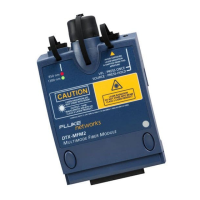Diagnosing Copper Cabling Faults
Common Causes of Copper Cabling Failures
6-5
6
Table 6-1. Diagnosing Twisted Pair Test Failures (cont.)
-continued-
NEXT passes, but the plot shows that measurements exceed the limit
For ISO/IEC standards, NEXT is not evaluated where insertion loss is less than 4 dB (the 4 dB rule).
Return passes, but the plot shows that measurements exceed the limit
Return loss is not evaluated where insertion loss is less than 3 dB (the 3 dB rule).
Return loss gives FAIL, FAIL*, or PASS* result
•
Patch cord or cable impedance not 100 Ω
•
Patch cord handling causing changes in impedance
•
Excessive amount of cable jammed into outlet box
•
Tight service loops in telecommunications closet
•
Excessive untwisting of pairs at connector
•
Poor quality connectors
•
Cable impedance not uniform (poor quality cable)
Tip: The HDTDR test in Single Test mode features a scanning
function that runs the HDTDR test continuously. This
function can be helpful for locating return loss faults
caused by tight loops and cable compression. See page
6-12.

